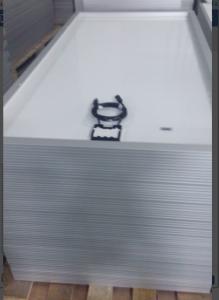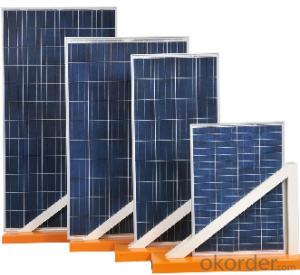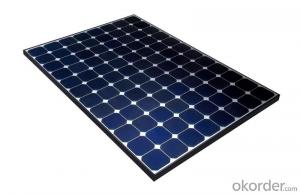Solar Panels Plano - CNBM Poly 245W Solar Panel with TUV UL CE Certificate for Residential
- Loading Port:
- Shanghai
- Payment Terms:
- TT OR LC
- Min Order Qty:
- 100 watt
- Supply Capability:
- 1000 watt/month
OKorder Service Pledge
OKorder Financial Service
You Might Also Like
Specification
CNBM Poly 245W Solar Panel with TUV UL CE Certificate For Residential
Introduction
Electrical connections are made in series to achieve a desired output voltage and/or in parallel to provide a desired current capability. The conducting wires that take the current off the modules may contain silver, copper or other non-magnetic conductive [transition metals]. The cells must be connected electrically to one another and to the rest of the system. Externally, popular terrestrial usage photovoltaic modules use MC3 (older) or MC4 connectors to facilitate easy weatherproof connections to the rest of the system.
Multiple solar cells in an integrated group, all oriented in one plane, constitute a solar photovoltaic panel or solar photovoltaic module. Photovoltaic modules often have a sheet of glass on the sun-facing side, allowing light to pass while protecting the semiconductor wafers. Solar cells are usually connected in series and parallel circuits or series in modules, creating an additive voltage. Connecting cells in parallel yields a higher current; however, problems such as shadow effects can shut down the weaker (less illuminated) parallel stringEach module is rated by its DC output power under standard test conditions, and typically ranges from 100 to 365 watts. The efficiency of a module determines the area of a module given the same rated output – an 8% efficient 230 watt module will have twice the area of a 16% efficient 230 watt module. There are a few solar panels available that are exceeding 19% efficiency. A single solar module can produce only a limited amount of power; most installations contain multiple modules. A photovoltaic system typically includes a panel or an array of solar modules, a solar inverter, and sometimes a battery and/or solar tracker and interconnection wiring.
Micro-inverted solar panels are wired in parallel which produces more output than normal panels which are wired in series with the output of the series determined by the lowest performing panel (this is known as the "Christmas light effect"). Micro-inverters work independently so each panel contributes its maximum possible output given the available sunlight.[6

Suggested application
Home lighting business lighting,
Garden lighting, pavement lighting
Farmer household lighting
Decorative water pump
Traffic signal lighting
Industry area
Business area
Solar Power Plant
Product feature
Modules are made of Monocrystalline or Polycrystalline Silicon cell.
Materials and color of the solar panel frame: Clear anodized aluminum alloy type 6063T5 Universal frame; Silver-white color;
The output connection gathers the coupling: Selects conforms to the IEC-612615; 2005, class II, IEC61730 international standard; Airtight waterproofing binding clamp;
Module seal structure: The surface is thick, the high diaphanous rate armored glass with solar cell board special-purpose 3.2mm becomes after the high temperature lamination craft. The back selects has waterproof and anti- aged performance fine TPT materials. The entire block battery board has, the waterproofing, the anti- aging airtight and so on the fine performance;
Power tolerance: +/-3%
Packaging
International standard cartons (according to the requirements of customers)
- Q: What is the biggest solar panel you can buy?How much energy can it produce in kwh?Thanks :)
- not really sure but you can check this....
- Q: Can solar panels be used in areas with high pollution levels?
- Yes, solar panels can be used in areas with high pollution levels. While pollution may slightly reduce the efficiency of solar panels by blocking some sunlight, they can still generate electricity. In fact, using solar panels in such areas can be beneficial as they provide a clean and renewable energy source, helping to reduce reliance on polluting fossil fuels.
- Q: I want to know that if I put solar panels in space if Pluto can recieve energy for iPods and television
- Two problems: ) solar flux. Around Earth, we receive solar energy to the tune of 370 W/m^2 (watts per square metre). In theory, if you have a solar panel of metre by one metre and place it (in space) directly perpendicular to the rays of the sun (meaning = the panel is facing the sun perfectly), you should get 370 watts of power. In practice, the panels are never 00% efficient so that you get less. The flux (just like the intensity of light) drops as the square of the distance increases. Pluto is -- on average -- 39 times further from the Sun, therefore the flux there will be reduced by a fraction of 39^2 = 52 times 370 / 57 = 0.9 W Even with 00% efficiency, you square metre panel will produce less than one watt, once you get it out to Pluto. 2) temperature It is very difficult to built a solar panel (with all the required wire connections) that remains flexible enough at Pluto's temperatures. Temperature drops as the 4th root of the flux (or, to make it easier, the square root of the distance). sqrt(39) = 6.25 Temperature at Pluto = Temperature at Earth / 6.25 (in degrees Kelvin -- also known as Absolute Temperature) At best, temperature around here is 300 K (it is less than that, but 300 makes the calculation easier) 300 / 6.25 = 48 48 K = -225 C = -373 F wires and insulation become very brittle at these temperatures... and one watt of power flowing through the wires will NEVER be enough to warm them up (never mind running the iPod).
- Q: How do I choose the right size of solar panels for my home?
- To choose the right size of solar panels for your home, you should consider factors such as your average electricity consumption, available roof space, and budget. Start by analyzing your energy usage over the past year to determine your average daily kilowatt-hour (kWh) consumption. Next, calculate the solar panel system size needed by dividing your average daily consumption by the average daily sunlight hours in your area. Additionally, assess your roof's orientation, shading, and structural capacity to determine the maximum number of panels it can accommodate. Finally, take your budget into account and consult with a professional solar installer to help you determine the appropriate size and type of solar panels that best meet your energy needs.
- Q: What is the efficiency of solar panels?
- The efficiency of solar panels refers to how effectively they convert sunlight into usable electricity. Generally, the efficiency of solar panels ranges from 15 to 20 percent, with some advanced models achieving efficiencies of up to 23 percent. However, it's important to note that the efficiency can vary depending on various factors such as the type of panel, its age, location, and environmental conditions.
- Q: Can solar panels be used for powering outdoor events or festivals?
- Yes, solar panels can definitely be used to power outdoor events or festivals. They are a sustainable and reliable source of energy that can provide electricity to run lights, sound systems, food stalls, charging stations, and other equipment needed for such events. Additionally, solar panels can be easily set up in open areas, making them ideal for powering outdoor gatherings without the need for grid electricity or noisy generators.
- Q: what kind of rays are used in solar panels?
- Electromagnetic...meaning light rays, primarily in the visible spectrum. Ultraviolet and infrared light rays actually degrade most types of solar panels, limiting their useful lifetime. That said, your question is not stated well...so I'm not sure if that's the information you were looking for. Rays are not used in solar panels...rather solar panels are used to collect sunlight and convert it to energy--either directly into heat in the case of passive solar, or into electricity by the use of photovoltaic cells.
- Q: Can solar panels be used in remote areas without access to the grid?
- Yes, solar panels can be used in remote areas without access to the grid. Solar panels generate electricity by harnessing sunlight, and they can operate independently of the grid. This makes them an ideal solution for remote areas where setting up power lines and accessing the grid may be difficult or costly. Solar panels can provide a reliable and sustainable source of electricity in such areas, allowing for various applications like powering homes, schools, clinics, and even small businesses.
- Q: i need to make a solar panel model for a project in science and i would like to know how to build a easy model at home that wont cost alot
- There are different types of solar panels. Photovoltaic for electricity, and thermal for heating water, and passive for heating air. So it would help if you would say what type you are going to build. Theere are a lot of videos on you tube on how to make solar panels. use the link below.
- Q: a fiber optic network could distribute solar energy from warm states to the rest of the country. Using a Federally created program,the energy would be used through a trust program to benefit all of our citizens equally. It would create thousands of jobs and help us with our dependence on foriegn oil supplies. This is no different than work programs created by the Feds during the 930's depression era.
- It's not a matter of Federal money or Federal programs or attitudes of the government that keeps your grand plan for generating large amounts of electrical power using solar panel systems and distributing it country wide with fiber optics from becoming a reality. It's technology. Whatever optimistic speculations you may have heard or read, large scale, dependable generation of electrical power at steady high levels from solar cells is nowhere near a reality. Some of the big culprits are the variable atmosphere of the earth and the inefficiency of practical and economic solar cells. The conversion does not depend on the warmth of the states where generation might take place but on constant direct sunlight, unobscured by clouds in the atmosphere for most of every day, and on high efficiency solar cells. No states can depend on clear skies 365 days of the year and there's the little matter of night time, when nothing would be generated. Also, the electricity generated by solar panels cannot be carried by fiber optics since they carry electromagnetic energy (light), not electricity. What may be possible sometime in the not-too-distant future is the use of solar panels to supplement, not replace, conventional power generating systems on a local basis. It would not be required that they provide constant high levels of power every day, but only that they provide power when conditions were right, in order to perform the valuable role of cutting down on the use of fossil fuels in conventional generating systems. (The direct current generated by solar panels would have to be converted to alternating current or stored in batteries to accommodate our present methods and equipment for using electric power.) As soon as this becomes technically and economically feasible, we will not have to wait long to hear about it from the energy corporations and politicians.
Send your message to us
Solar Panels Plano - CNBM Poly 245W Solar Panel with TUV UL CE Certificate for Residential
- Loading Port:
- Shanghai
- Payment Terms:
- TT OR LC
- Min Order Qty:
- 100 watt
- Supply Capability:
- 1000 watt/month
OKorder Service Pledge
OKorder Financial Service
Similar products
Hot products
Hot Searches
Related keywords


























